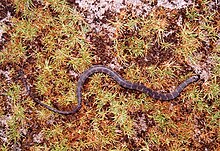Brown-banded water snake
| Brown-banded water snake | |
|---|---|

| |
| Scientific classification | |
| Kingdom: | |
| Phylum: | |
| Subphylum: | |
| Class: | |
| Order: | |
| Suborder: | |
| Family: | |
| Subfamily: | |
| Genus: | |
| Species: | H. angulatus
|
| Binomial name | |
| Helicops angulatus | |
| Synonyms | |
The brown-banded water snake (Helicops angulatus) is a species of aquatic snake found in tropical South America and Trinidad and Tobago.
Description
The brown-banded water snake grows to a maximum total length (including tail) of 78 cm (31 inches). Dorsally, it is olive or gray-brown, with dark brown, black-edged crossbands, which narrow at the sides, and are usually confluent with the black crossbands of the belly. There is a large dark rhomboid on the nape. Ventrally, it is yellowish (in alcohol) with black crossbands or black spots.
The dorsal scales are strongly keeled, even on the occiput and nape, and are arranged in 19 rows. Ventrals are 102-130 in number, the anal scale is divided, and the 61-94 subcaudals are paired and keeled.[2]
Habitat and diet
H. angulatus lives in fresh and brackish water, where it feeds on fish and possibly also freshwater eels and frogs.
Reproduction
H. angulatus has been reported to be "facultatively ovoviviparous".[citation needed]
References
- ^ "Helicops angulatus ". The Reptile Database. www.reptile-database.org.
- ^ Boulenger, G.A. 1893. Catalogue of the Snakes in the British Museum (Natural History), Volume I., Containing the Families ... Colubridæ Aglyphæ, part. London: Trustees of the British Museum (Natural History). (Taylor and Francis, printers). xiii + 448 pp. + Plates I-XXVIII. (Helicops angulatus, pp. 278-279).
Further reading
- Boos, Hans E.A. (2001). The snakes of Trinidad and Tobago. College Station, Texas: Texas A&M University Press. ISBN 1-58544-116-3.
- Freiberg, M.A. 1982. Snakes of South America. Hong Kong: T.F.H. Publications.189 pp. ISBN 0-87666-912-7. (Helicops angulatus, p. 99).
- Linnaeus, C. 1758. Systema naturæ per regna tria naturæ, secundum classes, ordines, genera, species, cum characteribus, diferentiis, synonymis, locis. Tomus I. Editio Decima, Reformata. Stockholm: L. Salvius. 824 pp. (Coluber angulatus, new species, p. 217). (in Latin).
External links
- Ford, Neil B., and Ford, David F. (2002) Notes on the Ecology of the South American Water Snake Helicops angulatus (Squamata: Colubridae) in Nariva Swamp, Trinidad. Caribbean Journal of Science 38: 129-132. PDF
